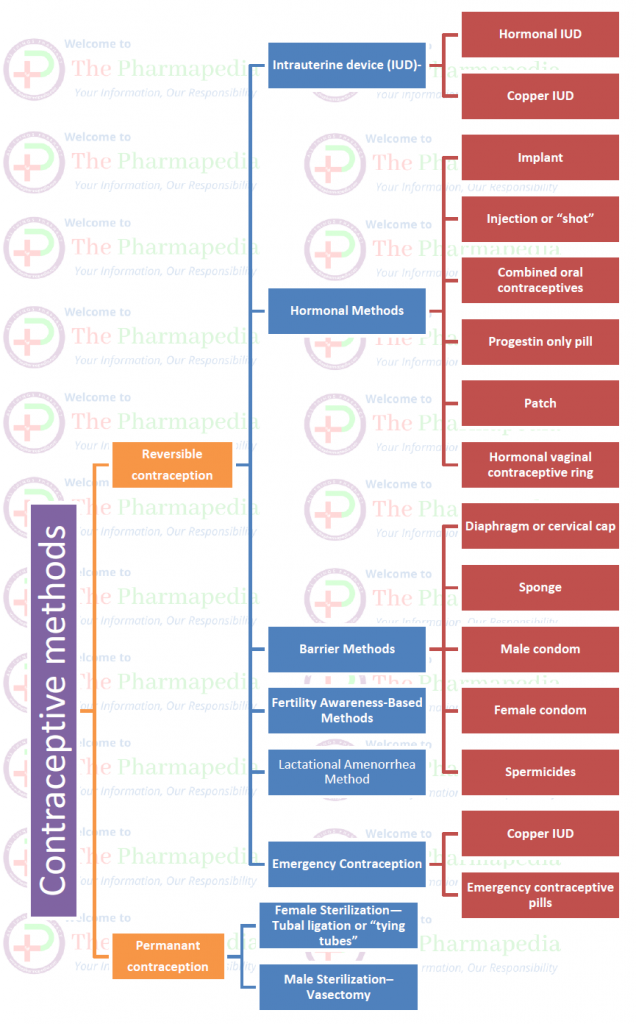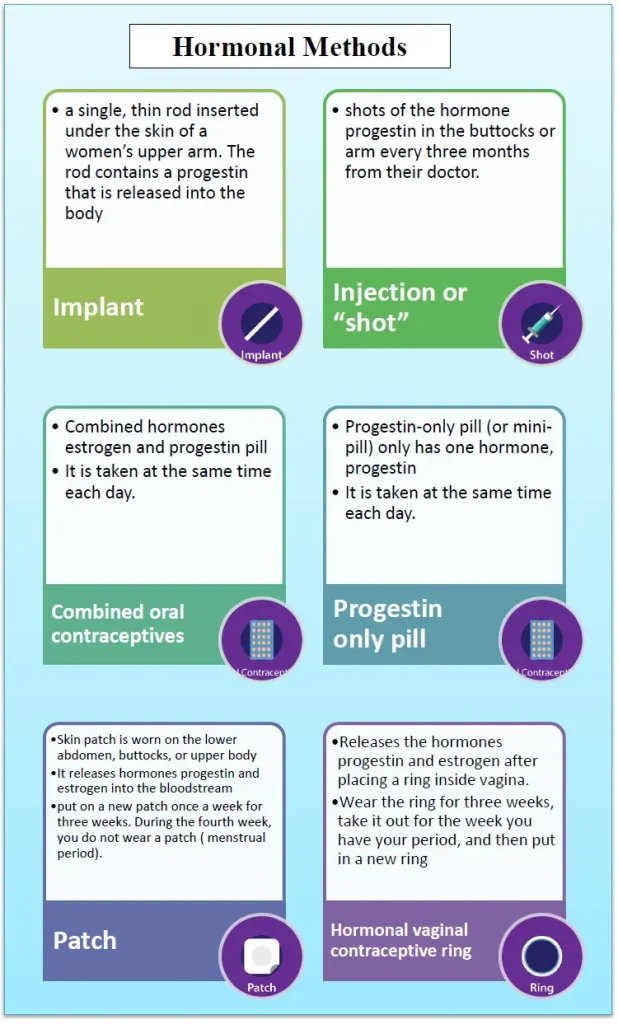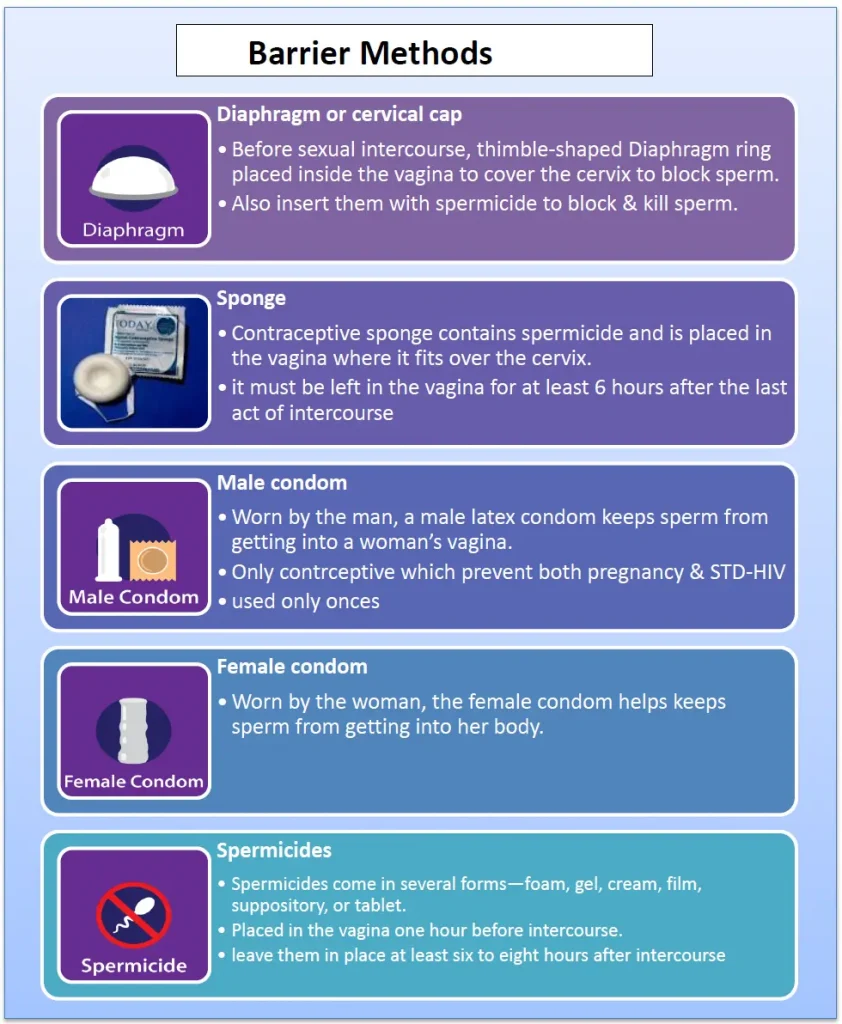India was the first country in the world to have launched a National Programme for Family Planning in 1952.
Goals of Family Planning includes:
- Achieve population stabilization by contraception methods
- Promote reproductive health
- Reduce maternal, infant & child mortality and morbidity
Family planning/contraception methods
Methods of contraception include, Oral contraceptive pills, Implants, Injectables, Patches, Vaginal rings, Intra uterine devices (IUD), Condom (male & Female), Sterilization (male and female), Lactational amenorrhea methods, Withdrawal and Fertility awareness based methods
Classification of contraception methods

A. Reversible contraception
1)Intrauterine device (IUD)-
An intrauterine device (IUD), also known as an intrauterine system (IUS), is a small, T-shaped device
T-shaped IUD is inserted into the uterus to prevent pregnancy.
An IUD can remain in place and function effectively for many years at a time. After the recommended length of time, or when the woman no longer needs contraception, a health care provider removes or replaces the device.

a. Hormonal IUD
- A hormonal IUD or IUS releases a progestin hormone (levonorgestrel) into the uterus.
- Mode of action-The released hormone causes thickening of the cervical mucus, inhibits sperm from reaching or fertilizing the egg, thins the uterine lining, and may prevent the ovaries from releasing eggs
b. Copper IUD
- A copper IUD prevents sperm from reaching and fertilizing the egg, and it may prevent the egg from attaching in the womb.
2) Hormonal Methods

a. Implant
- A single, thin rod surgically inserted under the skin of a women’s upper arm.
- The rod contains a progestin (etonogestrel) that is released into the body up to 5 yrs.
b. Injection or “shot”
- Shots/Injection of the hormone progestin (depot medroxyprogesterone acetate [DMPA]) in the buttocks or arm once every three months. from their doctor.
c. Combined oral contraceptives/COCs/”the pill”
- Contain Combined hormones synthetic estrogen (ethinyl estradiol) and progestin pill
- It is taken at the same time each day.
- work by inhibiting ovulation and thickening cervical mucus
Note: The combined estrogen/progestin drugs can be delivered by pills, a patch, or a vaginal ring.
d. Progestin only pill (POPs)/mini-pill
- Progestin-only pill (or mini-pill) only has one hormone, i.e. progestin
- It is taken at the same time each day.
- POPs may interfere with ovulation or with sperm function. POPs thicken cervical mucus, making it difficult for sperm to swim into the uterus or to enter the fallopian tube.
e. Patch
- thin, plastic patch that sticks to the skin is worn on the lower abdomen, buttocks, or upper body
- It releases hormones progestin and estrogen into the bloodstream
- put on a new patch once a week for three weeks. During the fourth week, you do not wear a patch ( menstrual period).
f. Hormonal vaginal contraceptive ring
- Releases the hormones progestin and estrogen after placing a ring (thin, flexible, and approximately 2 inches in diameter) inside vagina.
- Wear the ring for three weeks, take it out for the week you have your period, and then put in a new ring (about aftrer 7 days).
3) Barrier Methods

a. Diaphragm or cervical cap
- Before sexual intercourse, thimble-shaped Diaphragm ring placed inside the vagina to cover the cervix to block sperm.
- Insert them with spermicide to block & kill sperm.
- place for 6 to 8 hours after intercourse to prevent pregnancy
- Cervical caps– These are similar to diaphragms but are smaller and more rigid. The cervical cap is a thin silicone cup that is inserted into the vagina before intercourse to block sperm from entering the uterus
b. Sponge
- Contraceptive sponge are soft, disposable, spermicide-filled foam sponges and is placed in the vagina before intercourse where it fits over the cervix.
- it must be left in the vagina for at least 6 hours after the last act of intercourse
- block sperm from entering the uterus, and the spermicide also kills the sperm cells.
- Example- Today
c. Male condom
- Worn by the man, a male latex condom (covers the penis) keeps sperm from getting into a woman’s body.
- Only contraceptive which prevents both pregnancy & STD-HIV
- used only once
- Male condoms are made of latex or polyurethane
d. Female condom
- Worn by the woman, the female condom helps keeps sperm from getting into her body.
- single use
e. Spermicides
- Spermicides come in several forms—foam, gel, cream, film, suppository, or tablet.
- spermicidal agent is a chemical called nonoxynol-9 (N-9)
- Placed in the vagina one hour before intercourse.
- leave them in place at least six to eight hours after intercourse
4)Fertility Awareness-Based Methods
Fertility pattern is the number of days in the month when you are fertile (able to get pregnant), days when you are infertile, and days when fertility is unlikely, but possible.
If you have a regular menstrual cycle, you have about nine or more fertile days each month. If you do not want to get pregnant, you do not have sex on the days you are fertile, or you use a barrier method of birth control on those days.

5) Lactational Amenorrhea Method
For women who have recently had a baby and are breastfeeding, the Lactational Amenorrhea Method (LAM) can be used as birth control when three conditions are met: 1) amenorrhea (not having any menstrual periods after delivering a baby), 2) fully or nearly fully breastfeeding, and 3) less than 6 months after delivering a baby. LAM is a temporary method of birth control, and another birth control method must be used when any of the three conditions are not met.

6) Emergency Contraception

- Emergency contraception (EC) can prevent up to over 95% of pregnancies when taken within 5 days after intercourse.
- EC can be used in the following situations: unprotected intercourse, concerns about possible contraceptive failure, incorrect use of contraceptives, and sexual assault if without contraception coverage.
- Methods of emergency contraception are
a. Copper IUD
- Women can have the copper T IUD inserted within five days of unprotected sex.
- A copper-bearing IUD is the most effective ( nearly 100% effective) form of emergency contraception available.
b. Emergency contraceptive pills/ECP
- The emergency contraceptive pill
- Ulipristal acetate,
- Levonorgestrel, or
- Combined oral contraceptives (COCs) consisting of ethinyl estradiol plus levonorgestrel.
- ECP should not be used as a regular contraceptive method.
- Emergency contraception cannot interrupt an established pregnancy or harm a developing embryo.
Mechanism of EC
- Emergency contraceptive pills- prevent pregnancy by preventing or delaying ovulation (they do not induce an abortion).
- Copper-bearing IUD- prevents fertilization by causing a chemical change in sperm and egg before they meet. Emergency contraception cannot interrupt an established pregnancy or harm a developing embryo.
B. Permanent contraception
Sterilization is a permanent form of birth control that either prevents a woman from getting pregnant or prevents a man from releasing sperm.
1) Female Sterilization—Tubal ligation or “tying tubes”
a) Tubal ligation
- It is a surgical procedure in which a doctor cuts, ties, or seals the fallopian tubes. This procedure blocks the path between the ovaries and the uterus. The sperm cannot reach the egg to fertilize it, and the egg cannot reach the uterus.
b) Sterilization implant
- It is a nonsurgical method for permanently blocking the fallopian.
- Doctor threads a thin tube through the vagina and into the uterus to place a soft, flexible insert into each fallopian tube. No incisions are necessary. During the next 3 months, scar tissue forms around the inserts and blocks the fallopian tubes so that sperm cannot reach an egg. After 3 months, a health care provider conducts tests to ensure that scar tissue has fully blocked the fallopian tubes. A backup method of contraception is used until the tests show that the tubes are fully blocked.
2) Male Sterilization–Vasectomy
- Vasectomy is a surgical procedure that cuts, closes, or blocks the vas deferens which result into blockage the path between the testes and the urethra. The sperm cannot leave the testes and cannot reach the egg. It can take as long as 3 months for the procedure to be fully effective. A backup method of contraception is used until tests confirm that there is no sperm in the semen.
By their effectiveness
- Very effective (0–0.9 pregnancies per 100 women);
- Effective (1-9 pregnancies per 100 women);
- Moderately effective (10-19 pregnancies per 100 women);
- Less effective (20 or more pregnancies per 100 women)
Summery of All Contraceptive/Family Planning methods
| S. No. | Method | How it works | Effectiveness: pregnancies per 100 women per year with consistent and correct use | Effectiveness: pregnancies per 100 women per year as commonly used |
|---|---|---|---|---|
| 1 | Combined oral contraceptives (COCs) or “the pill” | Prevents the release of eggs from the ovaries (ovulation) | 0.3 | 7 |
| 2 | Progestogen-only pills (POPs) or “the minipill” | Thickens cervical mucous to block sperm and egg from meeting and prevents ovulation | 0.3 | 7 |
| 3 | Implants | Thickens cervical mucous to blocks sperm and egg from meeting and prevents ovulation | 0.1 | 0.1 |
| 4 | Progestogen only injectables | Thickens cervical mucous to block sperm and egg from meeting and prevents ovulation | 0.2 | 4 |
| 5 | Monthly injectables or combined injectable contraceptives (CIC) | Prevents the release of eggs from the ovaries (ovulation) | 0.05 | 3 |
| 6 | Combined contraceptive patch and combined contraceptive vaginal ring (CVR) | Prevents the release of eggs from the ovaries (ovulation) | 0.3 (for patch) 0.3 (for vaginal ring) | 7 (for patch) 7 (for contraceptive vaginal ring) |
| 7 | Intrauterine device (IUD): copper containing | Copper component damages sperm and prevents it from meeting the egg | 0.6 | 0.8 |
| 8 | Intrauterine device (IUD) levonorgestrel | Thickens cervical mucous to block sperm and egg from meeting | 0.5 | 0.7 |
| 9 | Male condoms | Forms a barrier to prevent sperm and egg from meeting | 2 | 13 |
| 10 | Female condoms | Forms a barrier to prevent sperm and egg from meeting | 5 | 21 |
| 11 | Male sterilization (Vasectomy) | Keeps sperm out of ejaculated semen | 0.1 | 0.15 |
| 12 | Female sterilization (tubal ligation) | Eggs are blocked from meeting sperm | 0.5 | 0.5 |
| 13 | Lactational amenorrhea method (LAM) | Prevents the release of eggs from the ovaries (ovulation) | 0.9 (in six months) | 2 (in six months) |
| 14 | Standard Days Method or SDM | Prevents pregnancy by avoiding unprotected vaginal sex during most fertile days. | 5 | 12 |
| 15 | Basal Body Temperature (BBT) Method | Prevents pregnancy by avoiding unprotected vaginal sex during fertile days | Reliable effectiveness rates are not available | |
| 16 | Two Day Method | Prevents pregnancy by avoiding unprotected vaginal sex during most fertile days, | 4 | 14 |
| Sympto-thermal Method | Prevents pregnancy by avoiding unprotected vaginal sex during most fertile | <1 | 2 | |
| 17 | Emergency contraception pills (ulipristal acetate 30 mg or levonorgestrel 1.5 mg) | Prevents or delays the release of eggs from the ovaries. Pills taken to prevent pregnancy up to 5 days after unprotected sex | < 1 for ulipristal acetate ECPs 1 for progestin-only ECPs 2 for combined estrogen and progestin ECPs | |
| 18 | Calendar method or rhythm method | The couple prevents pregnancy by avoiding unprotected vaginal sex during the 1st and last estimated fertile days, by abstaining or using a condom. | Reliable effectiveness rates are not available | 15 |
| 19 | Withdrawal (coitus interruptus) | Tries to keep sperm out of the woman’s body, preventing fertilization | 4 | 20 |
Also Read…
Join Our WhatsApp Group to receive the latest updates like Pharma Job notifications, study materials, admission alerts, Pharma News, etc
Join Our Telegram Group to receive the latest updates like Pharma Job notifications, study materials, admission alerts, Pharma News, etc
Join Our Telegram Group to Download Free Books & Notes, Previous papers for D.Pharm, B.Pharm, M.Pharm, Drug Inspector & GPAT……….

Comments are closed